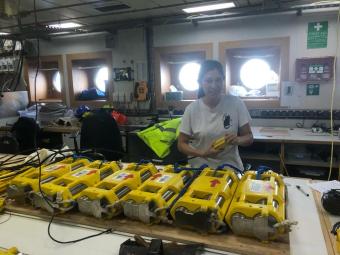With its depths teeming with diverse life and dynamic natural events, the Ocean is anything but silent. Advanced technology now gives scientists insight into the noise created by everything from underwater landslides, icebergs, ships and hydrothermal vents to whales, rain, marine engineering, and more.
For this month’s scientist spotlight, we caught up with National Oceanography Centre (NOC) Marine Seismologist Dr Gaye Bayrakci on her role in using innovative sound technology to gain a deeper knowledge of our changing seas.
What is your role in research at NOC?
I work as a Marine Seismologist at NOC, which means I study the structure of the subseafloor using waves. Although this is my job title, with the wide range of research carried out at NOC, I have also branched out into acoustics, which uses the sound waves to study the ocean and I really enjoy learning new skills.
Apart from working on various research projects, my role also involves leading and building up the seismo-acoustic facilities at NOC. Last year, three new colleagues joined us bringing more expertise in seismics and seismology, so now we have a small seismo-acoustics team within the Marine Geosystems subgroup.
We also recently invested in new tools for the facility to further our research. This includes an array of ocean bottom nodes equipped with a hydrophone and geophones capable of listening to the sound and elastic waves in the ocean and the subseafloor, and a new deep-tow seismic source that creates the waves that will be recorded by these nodes, specifically dedicated to showing the internal structure of small targets in deep sea environments, such as hydrothermal deposits or gas hydrates. It’s great to be part of this young and fast-growing seismo-acoustics team at NOC.
What drew you to working in this area?
I come from Istanbul. Istanbul is a megacity (18 million habitants) located on the northern edge of the Marmara Sea. The ~1350 km long North Anatolian Fault (NAF), cuts across the whole northern part of Turkey, and in the last century alone, it has produced 14 destructive earthquakes with magnitudes larger than 6.
Where the NAF enters the Marmara Sea, it splits into two branches, with the northern branch lying off-shore Istanbul. Along that branch, the 1999 Izmit (7.6) and Duzce (7.2) earthquakes broke both sides of the segment lying off-shore Istanbul and ever since, a big earthquake, potentially Mw> 7 is threatening the 18 million people living in the city. The Izmit and Duzce earthquakes happened when I was doing my undergraduate studies in geophysical engineering in Istanbul. I think this specific generation of Turkish geophysical engineers all wanted to become marine seismologists.
What science are you currently working on?
Like everyone at NOC, I work on a wide variety of projects. For example, in a project led by the University of Southampton, I am investigating the role of faulting and magmatism in the breakup of continents and new oceanic crust formation.
In a different project, I work on a similar subject, detachment faulting along mid-ocean ridges that carries the plate movements and that can slip with low angles (close to horizontal), the associated hydrothermal circulation and the marine mineral resources resulting from this circulation. This is a challenging topic for seismic methods because mid-ocean ridges are deep sea environments and hydrothermal systems and the associated seafloor mineralisation are very small targets. Hence, this work also involves the development of new seismic tools and methods to enable the imaging of these small targets. I also do some acoustics, for example, developing methods for measuring sea ice thickness using forward acoustic modelling. I also use the same geophysical modelling tools as a seismologist in projects related to the carbon capture and storage and Hydrogen storage.
What is your favourite thing about the work you do?
I love the fact that research topics are always changing, so there’s never time to get bored. I feel lucky to have expertise in seismology and seismics which are research subjects in themselves, for example, we can study the occurrence of earthquakes for geohazard purposes, but they are also geophysical tools which can be applied to other research domains. This allows me to apply my knowledge in other domains of science, for example contributing to biology studies by tracking marine mammals acoustically, helping biologists understand their behaviour, or by calculating sea ice thickness for climate modelling.
What impact does your science have on society?
As I work on a range of different topics, the impact is also diverse. I am lucky enough to work on both blue-sky science projects that allow us to understand our oceans, and on engineered solutions with a more direct impact on society. These include projects relevant to understanding and mitigating the impact of climate change, such as the determination of the sea ice thickness, and carbon capture and storage or hydrogen storage projects, and also relevant to marine mineral resources and protection, such as the seismic imaging of hydrothermal deposits.
More from Dr Gaye Bayrakci
A brand-new textbook “Noisy Oceans: Monitoring Seismic and Acoustic Signals in the Marine Environment” has brought to life the diverse soundscape of the ocean and its impacts on marine life and human society.
The book, published by AGU/Wiley & Sons and edited by Dr Gaye Bayrakci from the National Oceanography Centre (NOC) and Frauke Klingelhoefer from the French National Institute for Ocean Science (IFREMER) delivers a comprehensive guide to understanding the marine soundscape.

